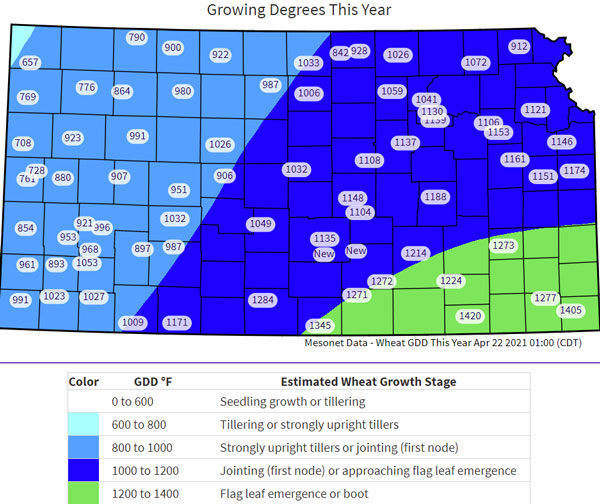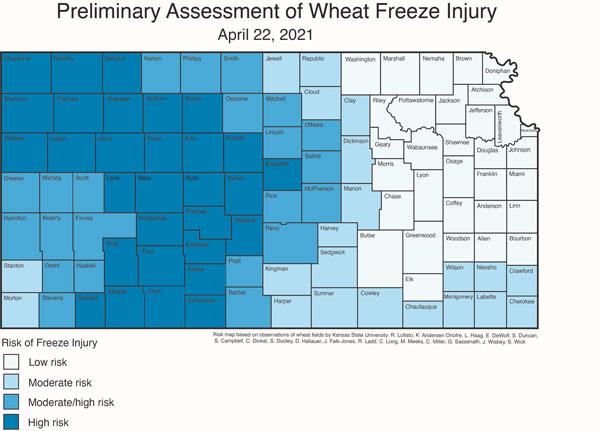Cold air temperatures occurred on April 20-22 and have potential to cause freeze injury to the 2021 Kansas wheat crop. Factors that influence the potential for freeze injury to wheat primarily include:
- Growth stage of the crop
- Air temperatures
- Duration of cold temperatures
- Soil temperatures
- Snow cover
Other factors, such as position in the landscape and presence of residue covering the soil surface, might also impact the extent of freeze damage within a field. The challenge is to integrate all these factors into a reasonable estimate of freeze injury.
Wheat growth stage around Kansas
Based on simple wheat development models and observations from K-State Extension personnel, the wheat growth stage around Kansas ranges from upright tillers to the first node in the northwest part of the state, from the first node to flag leaf emergence in central and southwest Kansas, and from flag leaf emergence to boot in the southeast region (Figure 1).
For fields that have not jointed yet, the crop generally withstands temperatures of 15-20°F fairly well, especially if the growing point is still below ground, which might be the case for some late planted wheat fields in northwest Kansas. If the growing point is already above ground (first joint visible), wheat can sustain temperatures down to about 24°F for a few hours. Minimum temperatures below 24°F for extended periods of time increase the risk of crop injury. Information from the K-State Mesonet indicates that air temperatures dipped below this 24-degree F threshold for as many as 18 hours in the northwest part of the state, as many as 4 hours in the southwest, up to 5 hours in the northeast and did not reach these temperatures in central or the rest of eastern Kansas. This total of hours (4-18 h) below the 24-degree F threshold can cause damage to fields at the first node of development or more advanced stages.
More advanced fields, such as second node to flag leaf emergence, are more vulnerable to freeze injury, as temperatures near the 24-28 degrees F threshold can cause injury. There were anywhere from 1.5-10 hours below the 28-degree F mark in parts of southwest and central Kansas, which increases the risk of freeze damage to the crop.

Figure 1. Estimated wheat growth stage as of April 22, 2021, for Kansas. Growth stage is estimated for each county based on temperatures accumulated in the season. Local growth stage may vary with planting date and variety. The KSU Wheat GDD Growth Stage model is available at: https://mesonet.k-state.edu/agriculture/wheat/gdd/
Snow cover and soil temperatures
While the snow cover (0.6-7.5 inches snow depth) helped buffer the cold temperatures on April 20; the snow quickly melted away and provided no buffer for the cold temperatures experienced on April 21 and 22.
While soil temperatures can help buffer freezing air temperatures if the growing point is below ground or near the soil surface, its buffering capacity decreases as the crop develops and the growing point moves away from the soil surface. Thus, we can expect a positive effect of the soil temperatures in north central and northwest Kansas where soil temperatures were sustained above 37°F during the entire week and the crop is around the first node stage of development. However, the more advanced crop in south central and southeast Kansas likely did not benefit as much from the soil temperature buffering capacity.
Integrated risk of freeze injury to Kansas wheat
Based on the factors above, we estimate that parts of southwest, central, and northwest Kansas are at the highest risk for freeze injury from the cold temperatures on April 20-22 (Figure 2). This area of high risk corresponds to: (i) areas with more hours below threshold for the predominant crop growth stage (northwest), and (ii) more advanced crop development with temperatures at or below the threshold for freeze damage for the corresponding stage (Figure 2). There was also some risk of freeze damage to more advanced crops in southeast Kansas. The risk of freeze injury decreases as we move to north central and northeast Kansas, because the crop is still behind in development and because the temperatures were not as cold. Across the entire state, the risk of freeze damage would be greater in the most advanced fields that are also more susceptible to freeze damage at higher temperatures.

Figure 2. Estimated risk of freeze damage due to a combination of wheat growth stage sensitivity, lowest temperatures during April 20-22, 2021, number of hours below 24 and 28 degrees F during the same period, cumulative snowfall during the period, and soil temperatures at the 2-inch depth. Map created by Erick DeWolf, K-State Research and Extension.
Symptoms of freeze injury
A detailed companion article in this eUpdate issue discusses the symptoms of freeze injury and what producers should be looking for over the next several days. Be sure to check it out!
Romulo Lollato, Wheat and Forage Specialist
lollato@ksu.edu
Erick DeWolf, Wheat Pathologist
dewolf1@ksu.edu
Kelsey Andersen Onofre, Extension Wheat Pathologist
andersenk@ksu.edu
Chip Redmond, Kansas Mesonet Manager
christopherredmond@ksu.edu
Mary Knapp, Weather Data Library
mknapp@ksu.edu